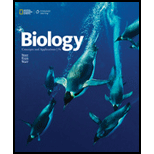
The first plants were_________.
| a. ferns | c. |
| b. flowering plants | d. conifers |
Introduction:
Plants are eukaryotic, multicellular and photosynthetic organism on Earth. The plants evolved 450 million years ago from a group of freshwater alga. These contain chlorophyll, which helps in the process of photosynthesis.
Answer to Problem 1SQ
Correct answer:
The first plants were bryophytes. Hence, the correct answer is option c.
Explanation of Solution
Reason for correct answer:
Option c. is given as, “bryophytes.”
Bryophytes are called first plants because they are capable of surviving in water as well as on land. They are commonly known as nonvascular plants. Bryophytes are categorized into three lineages: liverworts, mosses, and hornworts. They have internal conducting vessels. They obtain nutrients from the surface. They have a better capability to survive in unfavorable conditions such as drought. The vascular plants such as ferns and conifers have evolved from bryophytes.
Reason for incorrect answer:
Option a. is given as, “ferns.”
Ferns are called seedless vascular plants. They release spores into the environment that develop into a gametophyte. Ferns have fronds (leaves) and a horizontal underground stem. Hence, option a. is incorrect.
Option b. is given as, “flowering plants.”
Angiosperms are called flowering plants because these are the only plants that can make flowers and fruits. These have leaves, sepals, and petals. These are considered as the most evolved group of plants. Hence, option b. is incorrect.
Option d. is given as, “conifers.”
Conifers are included in the class of gymnosperms. These include various species of shrubs and trees. These can tolerate drought conditions as well as cold conditions. Conifers generally have naked seeds. Hence, option d. is incorrect.
Hence, the options a., b., and d. are incorrect.
Bryophytes were characterized by vessels and flagellated sperms. They do not have seeds, leaves, and stem. It is the reason bryophytes are considered as first plants. Thus, the correct option is c.
Want to see more full solutions like this?
Chapter 21 Solutions
Biology: Concepts and Applications (MindTap Course List)
- The following table is from Kumar et. al. Highly Selective Dopamine D3 Receptor (DR) Antagonists and Partial Agonists Based on Eticlopride and the D3R Crystal Structure: New Leads for Opioid Dependence Treatment. J. Med Chem 2016.arrow_forwardThe following figure is from Caterina et al. The capsaicin receptor: a heat activated ion channel in the pain pathway. Nature, 1997. Black boxes indicate capsaicin, white circles indicate resinferatoxin. You are a chef in a fancy new science-themed restaurant. You have a recipe that calls for 1 teaspoon of resinferatoxin, but you feel uncomfortable serving foods with "toxins" in them. How much capsaicin could you substitute instead?arrow_forwardWhat protein is necessary for packaging acetylcholine into synaptic vesicles?arrow_forward
- 1. Match each vocabulary term to its best descriptor A. affinity B. efficacy C. inert D. mimic E. how drugs move through body F. how drugs bind Kd Bmax Agonist Antagonist Pharmacokinetics Pharmacodynamicsarrow_forward50 mg dose of a drug is given orally to a patient. The bioavailability of the drug is 0.2. What is the volume of distribution of the drug if the plasma concentration is 1 mg/L? Be sure to provide units.arrow_forwardDetermine Kd and Bmax from the following Scatchard plot. Make sure to include units.arrow_forward
- Choose a catecholamine neurotransmitter and describe/draw the components of the synapse important for its signaling including synthesis, packaging into vesicles, receptors, transporters/degradative enzymes. Describe 2 drugs that can act on this system.arrow_forwardThe following figure is from Caterina et al. The capsaicin receptor: a heat activated ion channel in the pain pathway. Nature, 1997. Black boxes indicate capsaicin, white circles indicate resinferatoxin. a) Which has a higher potency? b) Which is has a higher efficacy? c) What is the approximate Kd of capsaicin in uM? (you can round to the nearest power of 10)arrow_forwardWhat is the rate-limiting-step for serotonin synthesis?arrow_forward

 Concepts of BiologyBiologyISBN:9781938168116Author:Samantha Fowler, Rebecca Roush, James WisePublisher:OpenStax College
Concepts of BiologyBiologyISBN:9781938168116Author:Samantha Fowler, Rebecca Roush, James WisePublisher:OpenStax College Biology (MindTap Course List)BiologyISBN:9781337392938Author:Eldra Solomon, Charles Martin, Diana W. Martin, Linda R. BergPublisher:Cengage Learning
Biology (MindTap Course List)BiologyISBN:9781337392938Author:Eldra Solomon, Charles Martin, Diana W. Martin, Linda R. BergPublisher:Cengage Learning Biology Today and Tomorrow without Physiology (Mi...BiologyISBN:9781305117396Author:Cecie Starr, Christine Evers, Lisa StarrPublisher:Cengage Learning
Biology Today and Tomorrow without Physiology (Mi...BiologyISBN:9781305117396Author:Cecie Starr, Christine Evers, Lisa StarrPublisher:Cengage Learning Biology: The Dynamic Science (MindTap Course List)BiologyISBN:9781305389892Author:Peter J. Russell, Paul E. Hertz, Beverly McMillanPublisher:Cengage Learning
Biology: The Dynamic Science (MindTap Course List)BiologyISBN:9781305389892Author:Peter J. Russell, Paul E. Hertz, Beverly McMillanPublisher:Cengage Learning





